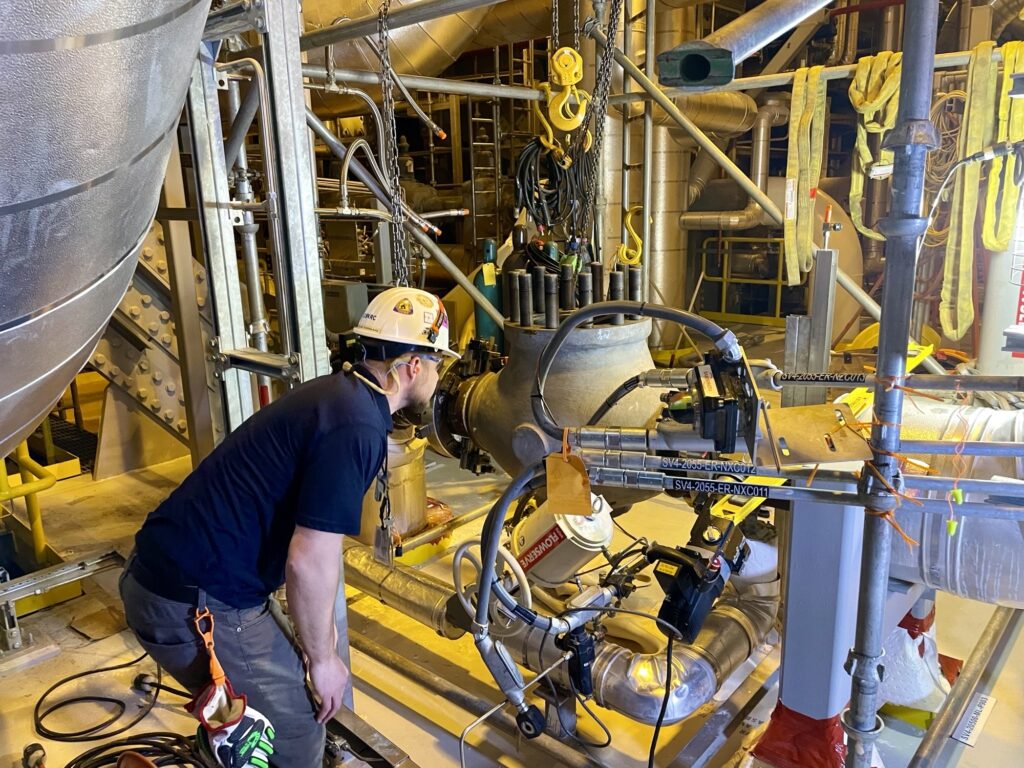
A Nuclear Regulatory Commission inspector checks out one of two reactors at the Vogtle power plant that came on line in Georgia, the only nuclear power plants built in the U.S. in decades. Photo courtesy Nuclear Regulatory CommissionPhoto courtesy Nuclear Regulatory Commission
In their commentary, “Maryland must not incentivize more nuclear power,” Jorge Aguilar and Tim Judson trot out the normal arguments against nuclear power, and some of their concerns are valid. What they fail to recognize is that except for the two recently completed Vogtle plants, the 93 reactors operating in the USA today are all of 1970s technology.
In the last 50 years, the technology has made huge strides. Comparing the new generation of Small Modular Reactors (SMRs) to those now operating is like comparing today’s super computers to the IBM 360 system of the 1970s with its tape drives, vacuum tubes and punched card input. No comparison.
Today’s nuclear industry has designed a new generation of power plants that, among other attributes, are:
- Factory assembled rather than field assembled, dramatically reducing the cost of production models.
- Shutdown-safe without pumps or off-site power required.
- Many operate at low pressures which reduces the hazards and higher costs for the old 2,200 psi plants.
- Operate at temperatures nearly twice that of the current operating reactors, which produces higher pressure steam and nearly 40% more thermal efficiency.
- Available to be used for process heat as well as electric generation.
- Designed to be combined to meet the incremental power needs of a user from 100 MWe (megawatts electric) to 1,000 MWe.
- Designed to have a smaller footprint than the prior designs and can be located on old coal power plant sites where much of the electric infrastructure already exists.
However, SMRs face two hurdles. First, is that the Nuclear Regulatory Commission is not accustomed to the new technologies and is struggling to determine how to review and license these new plants. Secondly, we must build prototypes of each of these innovative designs to know how easy they are to build, the projected cost of the nth model, and their actual operating efficiencies. Russia and China already have SMRs operating. We are behind.
Unfortunately, with electric deregulation in the 1990s, most electric utilities are no longer able to commit to the new plants and take the risk of the new technologies. Fortunately, data centers have stepped forward to underwrite the first commercial plants designed by innovative firms like TerraPower, Kairos Energy and X-Energy.
If the NRC can move expeditiously, these first plants will be in operation by 2030. Indeed, the SMRs will not make a substantial impact on total power generation in the USA until the 2040s. We could have begun building the prototypes 10-15 years ago. If we had, the most efficient plants would now be in mass production. A missed opportunity.
It is also worth noting that since the Three Mile Island Unit 2 accident in 1979, we have had about a collective 4,500 years of accident-free nuclear plant operation in the USA. That is a very strong industrial safety record. Without diminishing the severity of the TMI accident, no one was killed or injured and there was no property damage other than to the plant itself; hardly the worst industrial accident ever, as often claimed by those opposed to nuclear power.
What has inspired the high-tech industry seeking to build out their data centers to go with nuclear is that it is the only viable, CO2-free power source that is reliable 24 hours per day. Solar panels only produce output for about six hours per day and wind turbines average full power output for about 33% of the time.
For a 1 gigawatt data center, 4 gigawatts of solar panels would be required and battery storage for three-quarters of the output to keep the center operating around the clock. With small modular reactors, the same data center could be reliably powered with 11 modules of 100 MWe each. One module could be on standby or undergoing maintenance or refueling while the other 10 meet the 1 GW demand.
A mix of wind, solar and small modular reactors is the ideal for a carbon-dioxide-free energy sector. Maryland should endorse nuclear plants in its energy portfolio.

